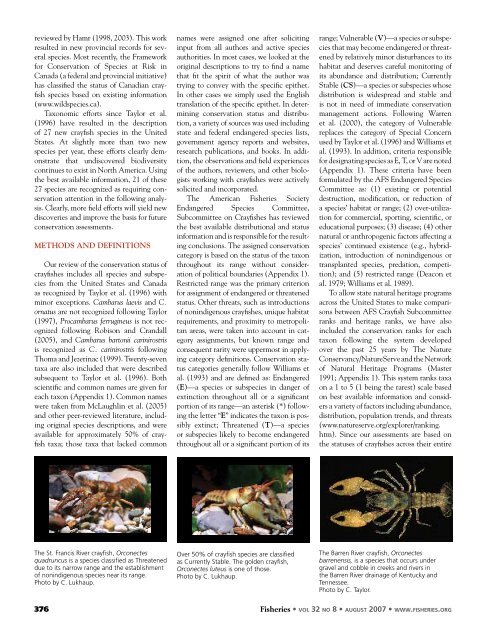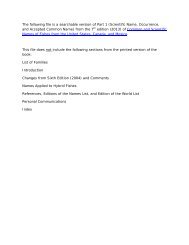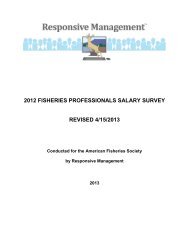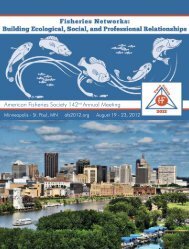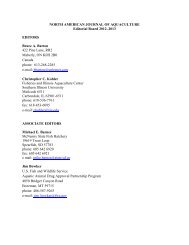Conservation Status of Crayfish Species Paddlefish Conservation ...
Conservation Status of Crayfish Species Paddlefish Conservation ...
Conservation Status of Crayfish Species Paddlefish Conservation ...
Create successful ePaper yourself
Turn your PDF publications into a flip-book with our unique Google optimized e-Paper software.
eviewed by Hamr (1998, 2003). This work<br />
resulted in new provincial records for several<br />
species. Most recently, the Framework<br />
for <strong>Conservation</strong> <strong>of</strong> <strong>Species</strong> at Risk in<br />
Canada (a federal and provincial initiative)<br />
has classified the status <strong>of</strong> Canadian crayfish<br />
species based on existing information<br />
(www.wildspecies.ca).<br />
Taxonomic efforts since Taylor et al.<br />
(1996) have resulted in the description<br />
<strong>of</strong> 27 new crayfish species in the United<br />
States. At slightly more than two new<br />
species per year, these efforts clearly demonstrate<br />
that undiscovered biodiversity<br />
continues to exist in North America. Using<br />
the best available information, 21 <strong>of</strong> these<br />
27 species are recognized as requiring conservation<br />
attention in the following analysis.<br />
Clearly, more field efforts will yield new<br />
discoveries and improve the basis for future<br />
conservation assessments.<br />
methOdS and deFinitiOnS<br />
Our review <strong>of</strong> the conservation status <strong>of</strong><br />
crayfishes includes all species and subspecies<br />
from the United States and Canada<br />
as recognized by Taylor et al. (1996) with<br />
minor exceptions. Cambarus laevis and C.<br />
ornatus are not recognized following Taylor<br />
(1997), Procambarus ferrugineus is not recognized<br />
following Robison and Crandall<br />
(2005), and Cambarus bartonii carinirostris<br />
is recognized as C. carinirostris following<br />
Thoma and Jezerinac (1999). Twenty-seven<br />
taxa are also included that were described<br />
subsequent to Taylor et al. (1996). Both<br />
scientific and common names are given for<br />
each taxon (Appendix 1). Common names<br />
were taken from McLaughlin et al. (2005)<br />
and other peer-reviewed literature, including<br />
original species descriptions, and were<br />
available for approximately 50% <strong>of</strong> crayfish<br />
taxa; those taxa that lacked common<br />
The St. Francis River crayfish, Orconectes<br />
quadruncus is a species classified as Threatened<br />
due to its narrow range and the establishment<br />
<strong>of</strong> nonindigenous species near its range.<br />
photo by c. lukhaup.<br />
names were assigned one after soliciting<br />
input from all authors and active species<br />
authorities. In most cases, we looked at the<br />
original descriptions to try to find a name<br />
that fit the spirit <strong>of</strong> what the author was<br />
trying to convey with the specific epithet.<br />
In other cases we simply used the English<br />
translation <strong>of</strong> the specific epithet. In determining<br />
conservation status and distribution,<br />
a variety <strong>of</strong> sources was used including<br />
state and federal endangered species lists,<br />
government agency reports and websites,<br />
research publications, and books. In addition,<br />
the observations and field experiences<br />
<strong>of</strong> the authors, reviewers, and other biologists<br />
working with crayfishes were actively<br />
solicited and incorporated.<br />
The American Fisheries Society<br />
Endangered <strong>Species</strong> Committee,<br />
Subcommittee on <strong>Crayfish</strong>es has reviewed<br />
the best available distributional and status<br />
information and is responsible for the resulting<br />
conclusions. The assigned conservation<br />
category is based on the status <strong>of</strong> the taxon<br />
throughout its range without consideration<br />
<strong>of</strong> political boundaries (Appendix 1).<br />
Restricted range was the primary criterion<br />
for assignment <strong>of</strong> endangered or threatened<br />
status. Other threats, such as introductions<br />
<strong>of</strong> nonindigenous crayfishes, unique habitat<br />
requirements, and proximity to metropolitan<br />
areas, were taken into account in category<br />
assignments, but known range and<br />
consequent rarity were uppermost in applying<br />
category definitions. <strong>Conservation</strong> status<br />
categories generally follow Williams et<br />
al. (1993) and are defined as: Endangered<br />
(e)—a species or subspecies in danger <strong>of</strong><br />
extinction throughout all or a significant<br />
portion <strong>of</strong> its range—an asterisk (*) following<br />
the letter “e” indicates the taxon is possibly<br />
extinct; Threatened (t)—a species<br />
or subspecies likely to become endangered<br />
throughout all or a significant portion <strong>of</strong> its<br />
over 50% <strong>of</strong> crayfish species are classified<br />
as currently Stable. The golden crayfish,<br />
Orconectes luteus is one <strong>of</strong> those.<br />
photo by c. lukhaup.<br />
range; Vulnerable (V)—a species or subspecies<br />
that may become endangered or threatened<br />
by relatively minor disturbances to its<br />
habitat and deserves careful monitoring <strong>of</strong><br />
its abundance and distribution; Currently<br />
Stable (CS)—a species or subspecies whose<br />
distribution is widespread and stable and<br />
is not in need <strong>of</strong> immediate conservation<br />
management actions. Following Warren<br />
et al. (2000), the category <strong>of</strong> Vulnerable<br />
replaces the category <strong>of</strong> Special Concern<br />
used by Taylor et al. (1996) and Williams et<br />
al. (1993). In addition, criteria responsible<br />
for designating species as E, T, or V are noted<br />
(Appendix 1). These criteria have been<br />
formulated by the AFS Endangered <strong>Species</strong><br />
Committee as: (1) existing or potential<br />
destruction, modification, or reduction <strong>of</strong><br />
a species’ habitat or range; (2) over-utilization<br />
for commercial, sporting, scientific, or<br />
educational purposes; (3) disease; (4) other<br />
natural or anthropogenic factors affecting a<br />
species’ continued existence (e.g., hybridization,<br />
introduction <strong>of</strong> nonindigenous or<br />
transplanted species, predation, competition);<br />
and (5) restricted range (deacon et<br />
al. 1979; Williams et al. 1989).<br />
To allow state natural heritage programs<br />
across the United States to make comparisons<br />
between AFS <strong>Crayfish</strong> Subcommittee<br />
ranks and heritage ranks, we have also<br />
included the conservation ranks for each<br />
taxon following the system developed<br />
over the past 25 years by The Nature<br />
Conservancy/NatureServe and the Network<br />
<strong>of</strong> Natural Heritage Programs (Master<br />
1991; Appendix 1). This system ranks taxa<br />
on a 1 to 5 (1 being the rarest) scale based<br />
on best available information and considers<br />
a variety <strong>of</strong> factors including abundance,<br />
distribution, population trends, and threats<br />
(www.natureserve.org/explorer/ranking.<br />
htm). Since our assessments are based on<br />
the statuses <strong>of</strong> crayfishes across their entire<br />
The Barren River crayfish, Orconectes<br />
barrenensis, is a species that occurs under<br />
gravel and cobble in creeks and rivers in<br />
the Barren River drainage <strong>of</strong> Kentucky and<br />
Tennessee.<br />
photo by c. Taylor.<br />
376 Fisheries • vol 32 no 8 • august 2007 • www.fisheries.org


